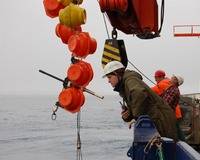Threat from wandering greenhouse gas
On the seafloor of the shallow coastal regions north of Siberia, microorganisms produce methane when they break down plant remains. If this greenhouse gas finds its way into the water, it can also become trapped in the sea ice that forms in these coastal waters. As a result, the gas can be transported thousands of kilometres across the Arctic Ocean and released in a completely different region months later. This phenomenon is the subject of an article by researchers from the Alfred Wegener Institute, published in the current issue of the online journal Scientific Reports. Although this interaction between methane, ocean and ice has a significant influence on climate change, to date it has not been reflected in climate models.
Litter Levels in the Arctic Depths On the Rise
The Arctic has a serious litter problem: in just ten years, the concentration of marine litter at a deep-sea station in the Arctic Ocean has risen 20-fold. This was recently reported in a study by researchers at the Alfred Wegener Institute, Helmholtz Centre for Polar and Marine Research (AWI). Plastic bags, glass shards and fishing nets: despite its location, far from any urban areas, the amount of litter in the depths of the Arctic Ocean continues to rise, posing a serious threat to its fragile ecosystem. Since 2002, AWI researchers have been documenting the amount of litter at two stations of the AWI’s “Hausgarten”, a deep-sea observatory network, which comprises 21 stations in the Fram Strait, between Greenland and Svalbard.
Warm Water Mixing up Life in Arctic
The warming of arctic waters in the wake of climate change is likely to produce radical changes in the marine habitats of the High North. This is indicated by data from long-term observations in the Fram Strait, which researchers from the Alfred Wegener Institute (AWI) have now analysed. Their most important finding: even a short-term influx of warm water into the Arctic Ocean would suffice to fundamentally impact the local symbiotic communities, from the water’s surface down to the deep seas. As the authors recently reported in the journal “Ecological Indicators”, that’s precisely what happened between 2005 and 2008. The Arctic is a remote and extreme habitat.
Plastic Litter Sea Surface, Even in Arctic
In a new study, researchers from the Alfred Wegener Institute, Helmholtz Centre for Polar and Marine Research (AWI) show for the first time that marine litter can even be found at the sea surface of Arctic waters. Though it remains unclear how the litter made it so far north, it is likely to pose new problems for local marine life, the authors report on the online portal of the scientific journal Polar Biology. Plastic has already been reported from stomachs of resident seabirds and Greenland sharks. Plastic waste finds its way into the ocean, and from there to the farthest reaches of the planet – even as far as the Arctic. This was confirmed in one of the first litter surveys conducted north of the Arctic Circle…
Polarstern Returns from Arctic
On Wednesday, 14 October 2015 the research icebreaker Polarstern from the Alfred-Wegener Institute, Helmholtz Centre for Polar and Marine Research (AWI), entered its homeport in Bremerhaven. Since mid-May, over 200 biologists, physicists, chemists, ice physicists, oceanographers and geoscientists have taken part in a total of four expeditions, with changes of personnel in Longyearbyen (Spitsbergen) and Tromsø (Norway). In the course of these five months, RV Polarstern covered over 16,000 nautical miles (more than 30,000 kilometres). Climate change is proceeding especially rapidly and intensively in the Arctic. Over the past few decades, the mean temperature in the High North has risen twice as fast as the global average.
Programmed Multikopter Flies Autonomously Through Arctic
How do you get an aircraft in the far reaches of the Arctic Ocean to the goal, if the compass does not provide reliable location data? Engineers aboard the research icebreaker Polarstern of the Alfred Wegener Institute programmed a Multikopter so that he can navigate near the North Pole, despite declination of the Earth's magnetic field. A first successful test flight together with autonomous landing celebrated scientists recently on an ice floe. "The autonomous navigation is in high latitudes is a major challenge," says Sascha Lehmenhecker, engineer at the Alfred Wegener Institute for Polar and Marine Research, the Helmholtz Centre for Polar and Marine Research (AWI). "Navigation is by means of magnetic sensors.
Research Icebreaker Sails for Arctic

The research vessel Polarstern has left Bremerhaven on course for the Arctic with 44 expedition participants from institutions from Germany, Belgium, USA and the United Kingdom who will spend around one month on board. Their main study area is the Fram Strait between Spitsbergen and Greenland where they will conduct long-term oceanographic measurements. The Fram Strait is the only deep sea water connection between the Arctic Ocean and the Atlantic. How much water is exchanged between these two seas and what heat and salt transport is associated with this?






